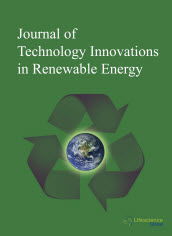jtire
|
|
|
Abstract: This paper presents a general view about biomass production in India and its potential energy for use in differentfields. India has tremendous potential for energy generation through biomass and its residues. Biomass energy is normally produced from firewood, agricultural residues such as bagasse, crop stalks, animal dung and wastes generated from agro-based industries. With the estimated and predicted values, the generating power from the surplus biomass in India was significant and it will continue to be more effective in future. Residue use as a fuel in India is estimated to be 216 Mt as projected value in 2010, recently, around 605 MW of electricity is being produced from biomass firing and 720 MW from cogeneration activities for residue. About 185 Mt (40%) of the dung collected is used as fuel in cook stoves. The potential for biogas production annually is 8750 million m3 from 251 Mt of dung. The amount of fuel-wood consumption during year 2004 was 205 million tonnesused as fuel for traditional cook stoves with low efficiency, 16 Mt used in industrial sector producing 10 PJ, and it was estimated that the production of fuel wood and charcoal increased to the rate of 1.98 per cent per annum. The total quantity of solid wastes generated in larger towns and cities has been estimated at 40 Mt in 2001, and in 2005 the average MSW generation in overall India was approximately 100,000 Mt/day. For the wastewater in India, in 2010, the energy estimated to be around 3929.8 TJ as energy value of CH4. Keywords: Biomass, energy, crop residues, animal manure, fuelwood and municipal solid wastes.Download Full Article |
|
|
|
Abstract: Crop residue constitutes a large fraction of biomass particularly in agricultural based economies like India. The most abundantly generated crop residues are paddy husk, paddy straw, coconut shell, cotton stalk and sugar cane trash. It is estimated that the potential of power generation using crop residue is close to 14 GWe in a country like India. Even though the potential is large, the main drawback with crop residue is that it is sparsely distributed and being of low density causes collection and transportation problem. This drawback could be converted into an advantage by adopting distributed power generation technologies. The distributed power generation would fare well in the power range of few hundred kilowatts and the most appropriate technology would be the biomass gasification technology. Among the biomass gasification technologies, the downdraft technology is ideally suited for power generation. The downdraft technology is proven with solid or woody biomass, whereas there are limitations in terms of acceptance of all types of crop residues. In this paper, performance study of two vastly differing crop residues, namely coconut shell and cotton stalk has been discussed; both the feedstocks have been tested in “post-harvested” condition with minimum amount of pre-processing. The performance with cotton stalk was found to be comparable at part load; however at higher load the gas composition deteriorated due to poor material movement within the reactor. This had implication in terms of maximum power generated. There was loss of power to an extent of 12%. The operational issues with post-harvested cotton stalk has been brought out which are based on detailed measurements. Keywords: Biomass Gasification, Crop Residue, Cotton Stalk, Coconut Shells.Download Full Article |
|
|
|
Abstract: The gradual depletion of world petroleum reserves and the impact of environmental pollution due to increasing exhaust emissions have necessitated the urgent need to develop alternative energy resources, such as biodiesel fuel. Vegetable oil is a promising feedstock because it has several advantages; it is renewable and environmental friendly. The present study involves extraction of oil from Allamanda cathertica seed (Allamanda), Azadarachta indica and Jatropha caucus; conversion of the oil into biodiesel and the characterization of the methyl ester. Transesterification of the different feed stocks was conducted using sodium methaoxide (NaMt), sodium ethaoxide(NaEt), potassium methaoxide (PMt) and potassiumethaoxide (PEt) as catalysts, using a range of reaction temperatures (45, 50, 55, 60 and 65OC) and different rates of stirring. Result showed that Allamanda seed produced 54% oil yield using mechanical extraction. The biodiesel yield was 97% using NaMt and NaEt as catalysts, while azadarachta oil gave 95% yield with PEt catalyst alone. Jatropha oil gave a yield of 70% biodiesel with all the catalysts used. The yield of biodiesel from Allamanda oil with respect to temperature were 63, 88, 94, 46 and 20% respectively. Characterization of the biodiesel produced from Allamanda oil compared favorably with the ASTM standards, viscosity 5.4, flash point 115OC, refractive index 1.4756 and energy value 35.0MJ/L. The GCMS analysis of Allamanda methyl ester showed a range of 10 different methyl esters which includes hexadecanoic acid (24%), linoleic acid (14.8%), 13-Decosenoic acid (35.3%), 9-Octadecanoic acid (13.5%). The work concludes that allamanda oil could be a good and alternative feedstock to the edible feedstocks currently in use for biodiesel production. Keywords: Biodiesel, non-edible feed stock, allamanda oil, environmental friendly.Download Full Article |


